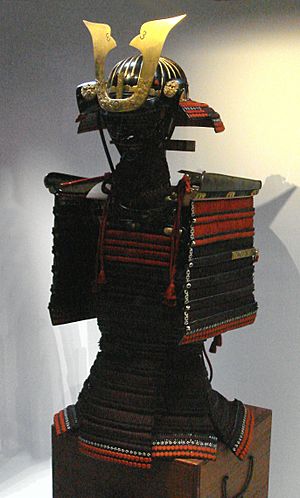John Saris facts for kids

John Saris (born around 1580, died 1643) was an important English merchant. He led the first English trip to Japan. This journey started from London in 1611. He sailed on a ship called the Clove. Saris had worked in Asia before. He spent over five years in Java, where England had a trading post. In 1613, he finally reached Japan. His visit opened up trade between England and Japan.
Contents
Journey to Japan
John Saris left London in 1611. His goal was to reach Japan. On his way, he stopped in Yemen. He missed India, which he had planned to visit. Instead, he went to Java. Java had the only permanent English trading station in Asia at that time.
Saris had been a merchant in Java before. He was part of the East India Company's second voyage. He returned to London in 1610. In 1612, he arrived in Java again. From there, he sent most of his ships home. He took only one ship, the Clove, to Japan. The Clove arrived in Japan in the summer of 1613.
Meeting the Shogun
Another Englishman, William Adams, had reached Japan earlier. Adams arrived in 1600 on a Dutch ship. He became an advisor to the Japanese ruler, called the Shogun. Adams helped Saris a lot.
Thanks to Adams, Saris met the powerful retired Shogun, Tokugawa Ieyasu. He also met Ieyasu's son, Tokugawa Hidetada, who was the current Shogun. Ieyasu promised England many trade benefits. Both Ieyasu and Adams suggested the port of Uraga for trade. This port was close to Edo (modern Tokyo), the Shogun's capital.
However, Saris chose a different location for the English trading post. He picked Hirado. This was a small island off Kyūshū, a large southern island of Japan. The Dutch were already trading successfully there. Hirado also saved the English ships from sailing along dangerous coasts.
Special Gifts
Saris was welcomed in Japan partly because of an amazing gift he brought. It was a very large telescope. This telescope was covered in silver and gold. It was the first telescope ever to leave Europe. It was also the first telescope given as a gift from one ruler to another. Sadly, this special telescope no longer exists today.
After a few months, in late 1613, Saris sailed back to England. He left Richard Cocks in charge of the Hirado trading post.
Trade Challenges
The English trading efforts in Japan did not go well. The main product England wanted to sell was woollen cloth. However, the cloth often rotted during the long journey. This made it hard to sell in Japan.
English attempts to trade with China also failed around this time. Because of these problems, the Hirado trading post was closed in 1623. It was meant to be a temporary closure, but it never reopened.
Return to England
Saris brought back gifts for King James from Japan. These were given in thanks for the telescope. Ieyasu sent stunning paintings. The Shogun himself sent two suits of armor. These suits of armor still exist today.
John Saris became very rich from his voyage. He married Anne Megges. She was the daughter of a wealthy London merchant. Anne died in 1623, when she was 29. She died eight years after they married. Saris never married again.
He then moved to a beautiful house in Fulham, near the River Thames. The house was called Goodriches. He lived there quietly until he died in 1643.
John Saris's Legacy
John Saris died on December 11, 1643. He was buried on December 19. His tombstone can still be seen in All Saints Church in Fulham. It is a large black stone on the floor near the altar. It shows the symbols of his family and his wife's family.
His will, a legal document about his property, was written in 1643. He left most of his wealth to the children of his half-brother, George. He also left thirty pounds to the poor people of Fulham. This money was used to buy bread. Thirty poor people received two-penny loaves of bread every Sunday after church until the money ran out.
Saris's travel journals were published in 1900. They were called The Voyage of Captain John Saris to Japan, 1613.
See also
- Anglo-Japanese relations
- List of Westerners who visited Japan before 1868

